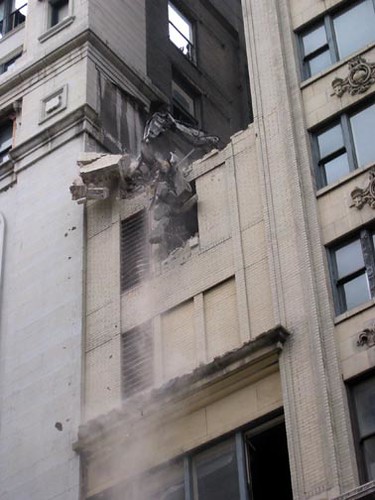Updated --The repercussions of the Century Building Demolition in St. Louis
 Demolition of the Century Building in St. Louis. Photo by Alan Brunettin.
Demolition of the Century Building in St. Louis. Photo by Alan Brunettin.For us preservation advocates, the efforts of the local preservation organization to "Save the Century" in the face of historic preservation tax credit financing!!!! ifrom the National Trust has been a difficult quest. See this blog entry from March "Historic Preservation: Profession or Calling?"
There was even a session about this at the National Trust meeting in Portland, and the anti-demolition side acquitted itself well. There have been changes in NTHP procedures as a result, and these are necessary changes.
It's a tough issue. The building was torn down for parking (kind of like the Poletown neighborhood in Detroit was destroyed for a parking lot for the now since closed GM Poletown Plant, and the demolition of a neighborhood could have been avoided by constructing a parking structure rather than a surface lot). But the tenants for the Post Office building adaptive reuse project didn't want to have to walk from a nearby parking structure. This is one of the problems of automobile-centricity. They wanted in-building or connected parking, so that's why the Century Building was targeted for destruction.
Today I received this email from the National Trust:
As many of you know, during the last few years, the National Trust has been involved in a difficult revitalization situation that involved both the rehabilitation of the U.S. Post Office and the consequent loss of the Century Building in St. Louis, Mo. In an effort to explain the National Trust's reason for approving and participating in this compromise, we have prepared a "Case Study, U.S. Post Office and the Century Building." If you would like a copy, please e-mail or call 202-588-6141 and we will be happy to send you either the PDF (4MB) or a printed copy in the mail.
You can imagine I've already requested my copy.
The case still goes on. The developer sued the original plaintiffs in a lawsuit that would be categorized as a "Strategic Lawsuit Against Public Participation." The developer, in the words of a high-level NTHP official, is "an a******." If that isn't a reminder to choose our partners carefully, I don't know what is. See this blog entry, "Century Building SLAPP Suit in Court Today," from the St. Louis Urban Review blog (to be added to the links on the right) for more about the lawsuit.
The Save the Century folks have a legal defense fund, and you should consider donating to it.
_______
I was just digging through my emailbox and I missed what Matt Ghio wrote about this yesterday (slightly edited)--
For those of you who weren't one of the 500+ folks who attended the national conference session that addressed the demolition of the Century Building in Portland, or for those of you who were not emailed the OPO case study published on 11/15 by the NT, you can email me and I will email you a copy of the case study. The case study is 76 pages and I recommend it to anyone interested in the issues raised by what happened in St. Louis.
If you don't read the case study, there are two major policy changes adopted by the Trust regarding the National Trust Community Investment Corporation (NTCIC). These policy changes were requested by Landmarks Association of St. Louis, Inc. and others. Here are the two changes:
1) The NTCIC will seek the endorsement of the NT regional office and a local preservation group for its projects; and
2) the NTCIC will not participate in a project that includes the demolition of a NR listed or eligible building except under exceptional circumstances and then only with the written approval of the NT president.
Although I am a board member of Landmarks, the following opinions are mine alone. Despite Richard Moe's statement to the contrary in his cover letter, I do not believe this case study is a "full explanation" of what happened in St. Louis. Landmarks was not asked to help prepare this case study. Landmarks was only asked, after the case study was completed, to provide remarks that would be included. Landmarks was not even allowed to see the case study - although it had already been written -before it submitted its remarks. From my perspective, the leadership of the NT has made the same mistake it made in January, 2002 - it chose to unilaterally take another position on St. Louis without finding it necessary to colloborate with the local preservation organization that knows the community best. This case study is sadly just another lost opportunity.
Suffice it to say for now, there are several material factual errors and omissions that render this OPO case study incomplete and misleading.
______
Well, you should know my take on this--that transparency and openness is a good thing.
Two gutsy happenings at the Trust conference (neither by me). I mentioned how a woman from SF challenged the VP of marketing for HGTV, stating the network is very much oriented to tearing out the more than usable and replacing it with new, and is really anti-sustainabilty.
And at the "Annual Meeting" which is really a formality, probably like a stockholders meeting in Japan (they hire Japanese mafia to strong-arm dissidents), where the audience doesn't speak. Anyway, a person from Ohio tried to get the St. Louis item on the agenda of the meeting, making public comments in a session where there is no agenda item for public comments.



0 Comments:
Post a Comment
<< Home